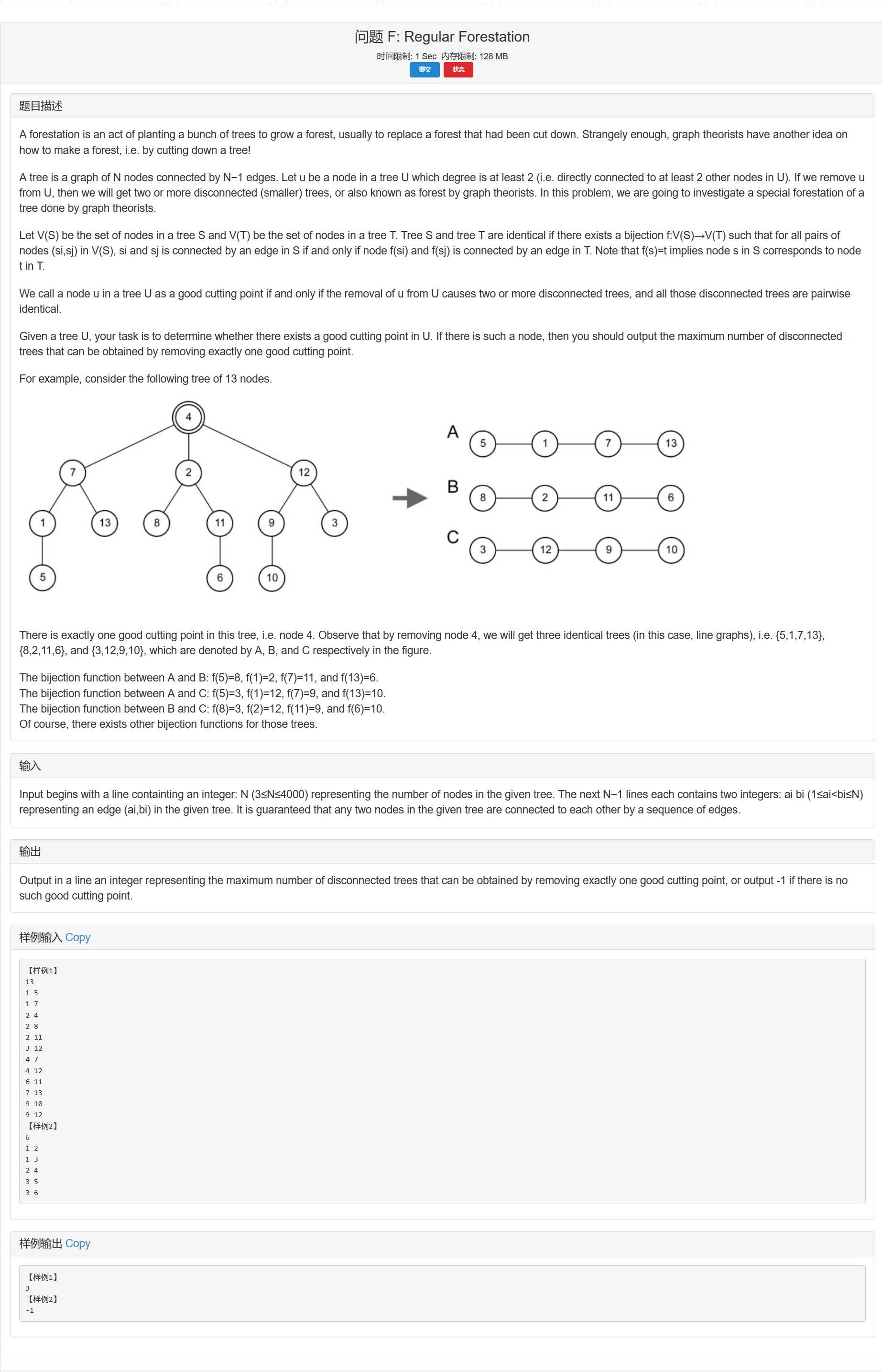哈希算法在判定树同构方面的应用
在上一篇文章中我们介绍了 枚举根节点哈希 和 求重心哈希 两种方法来判断两棵无根树是否同构。
但是如果有些题目中我必须要计算出每个根节点的 f f f 值,且 n ≤ 1 e 5 n\le 1e5 n≤1e5,我们要怎么办呢?
考虑以下问题。
(一):洛谷–P4323 [JSOI2016]独特的树叶
题解:
考虑如下解法。
我们求解 A A A 树中,以每一点 x x x 为根的 f [ x ] f[x] f[x] 值并保存。
我们枚举 B B B 树中的叶子节点,计算删去这个叶子节点后,这个叶子节点的父亲的 f f f 值,即计算 f [ f a t h e r [ 当 前 叶 子 ] ] f[father[当前叶子]] f[father[当前叶子]]。
如果在 A A A 树的 f [ x ] f[x] f[x] 中存在一个值与 f [ f a t h e r [ 当 前 叶 子 ] ] f[father[当前叶子]] f[father[当前叶子]] 相等,那就说明对于 B B B 树中以某一点 y y y 为根的 f [ y ] f[y] f[y],在 A A A 树中能找到一点 x x x,使得以 x x x 为根的 f [ x ] = f [ y ] f[x]=f[y] f[x]=f[y]。那么 A A A 树与 B B B 树同构,当前叶子节点符合要求。
当前问题的关键点转化为怎么快速求出,无根树中,以任意一点 x x x 为根的 f [ x ] f[x] f[x]
我们将当前无根树转化为根节点为 1 1 1 的有根树。
对根节点 1 1 1 进行求解,得到 f [ 1 ] f[1] f[1] ,此时各点 f [ x ] f[x] f[x] 表示整棵树以 1 1 1 为根,且当前为 节点 x x x 子树的哈希值。
我们设一个辅助数组 g [ x ] g[x] g[x],表示整棵树以 x x x 为根的哈希值,初始时 g [ 1 ] = f [ 1 ] g[1]=f[1] g[1]=f[1]。
假设 y ∈ s o n x y\in son_x y∈sonx,且当前 g [ x ] g[x] g[x] 已求出,考虑怎么求解 g [ y ] g[y] g[y]。
我们已经求出 f [ y ] = 1 + ∑ z ∈ s o n y a n d z ≠ x f [ z ] ∗ p [ s i [ z ] ] f[y]=1+\sum\limits_{z\in son_y\space and\space z\neq x}f[z]*p[si[z]] f[y]=1+z∈sony and z=x∑f[z]∗p[si[z]],我们要得到以 y y y 为根的哈希值 g [ y ] g[y] g[y]。
g [ y ] = f [ y ] + g[y]=f[y]+ g[y]=f[y]+ (以 y y y 为根的树中,子树 x x x 的哈希值) ∗ p [ n − s i [ y ] ] *p[n-si[y]] ∗p[n−si[y]]。
其中 ( 以 y y y 为根的树中,子树 x x x 的哈希值 ) 等于 ( g [ x ] − f [ y ] ∗ p [ s i [ y ] ] ) (g[x]-f[y]*p[si[y]]) (g[x]−f[y]∗p[si[y]])。
n − s i [ y ] n-si[y] n−si[y] 为以 y y y 为根时, x x x 子树的大小。
其中 n n n 为这棵树的大小。
即 g [ y ] = f [ y ] + ( g [ x ] − f [ y ] ∗ p [ s i [ y ] ] ) ∗ p [ ( n − s i [ y ] ) ] g[y]=f[y]+(g[x]-f[y]*p[si[y]])*p[(n-si[y])] g[y]=f[y]+(g[x]−f[y]∗p[si[y]])∗p[(n−si[y])],那么我们再进行一遍 d f s dfs dfs 即可以求出 g [ x ] g[x] g[x]。
g [ x ] g[x] g[x] 为以 x x x 为根的哈希值。
回到本题:
(1)求解 A 树的 g [ x ] g[x] g[x] 并保存至 s e t set set 中。
(2)求解 B 树的 g [ x ] g[x] g[x]
(3)枚举叶子节点,检查去掉叶子节点后 B B B 树与 A A A 树是否同构。
空间复杂度 O ( n ) O(n) O(n),时间复杂度 O ( n l o g n ) O(nlogn) O(nlogn) , l o g n logn logn 是因为维护了 s e t set set。
代码:
#include<iostream>
#include<cstdio>
#include<algorithm>
#include<cstring>
#include<string>
#include<vector>
#include<map>
#include<set>
#include<cmath>
#include<queue>
#define ll long long
#define llu unsigned ll
#define pr make_pair
#define pb push_back
#define lc (cnt<<1)
#define rc (cnt<<1|1)
using namespace std;
const int inf=0x3f3f3f3f;
const ll lnf=0x3f3f3f3f3f3f3f3f;
const double dnf=1e15;
const int mod=1e9+7;
const int maxn=1000100;
int head[maxn],ver[maxn],nt[maxn],d[maxn];
int fa[maxn],si[maxn],tot=1,n;
llu g[maxn],f[maxn];
int p[maxn<<1],cnt=0;
bool ha[maxn<<1];
set<llu> se;
//素数筛,可以先打表看一下,素数筛的上界
void prime(void)
{
ha[1]=true;
for(int i=2;i<(maxn<<1);i++)
{
if(!ha[i]) p[++cnt]=i;
for(int j=1;j<=cnt&&i*p[j]<(maxn<<1);j++)
{
ha[i*p[j]]=true;
if(i%p[j]==0) break;
}
}
}
//初始化存图
void init(void)
{
memset(head,0,sizeof(head));
tot=1;
n++;
}
void add(int x,int y)
{
ver[++tot]=y,nt[tot]=head[x],head[x]=tot;
}
//处理f[x]
void dfs1(int x,int ff)
{
f[x]=si[x]=1;
for(int i=head[x];i;i=nt[i])
{
int y=ver[i];
if(y==ff) continue;
dfs1(y,x);
f[x]+=f[y]*p[si[y]];
si[x]+=si[y];
}
}
//求解 g[x],g[x]为以x为根的哈希值
void dfs2(int x,int ff)
{
for(int i=head[x];i;i=nt[i])
{
int y=ver[i];
if(y==ff) continue;
g[y]=f[y]+(g[x]-f[y]*p[si[y]])*p[n-si[y]];
dfs2(y,x);
}
}
int main(void)
{
prime();
scanf("%d",&n);
int x,y;
for(int i=1;i<n;i++)
{
scanf("%d%d",&x,&y);
add(x,y);
add(y,x);
}
dfs1(1,0);
g[1]=f[1];
dfs2(1,0);
//保存A树的
for(int i=1;i<=n;i++)
se.insert(g[i]);
init();
for(int i=1;i<n;i++)
{
scanf("%d%d",&x,&y);
d[x]++,d[y]++;
add(x,y);
add(y,x);
fa[x]=y,fa[y]=x;//注意这里叶子节点怎么找它的上一节点
}
dfs1(1,0);
g[1]=f[1];
dfs2(1,0);
//枚举叶子节点
for(int i=1;i<=n;i++)
{
//g[fa[i]]-p[1],因为叶子节点的大小一定为1,
//这个值就是去掉叶子节点后,以fa[i] 为根的树的哈希值。
if(d[i]==1&&se.find(g[fa[i]]-p[1])!=se.end())
{
printf("%d\n",i);
break;
}
}
return 0;
}
(二)综合练习:石油大–17102、Regular Forestation
这个 O J OJ OJ 可能会上不去。
CF题目:CodeForces – 1252F
题面:
题意:
给定一棵无根树,如果去掉点 x x x 且去掉与点 x x x 相连的边,剩下的部分是由 k k k 棵树组成的森林,且这 k k k 棵树同构,且 k > 1 k>1 k>1 。那么称 x x x 是一个好的切分点。
输出去掉某一个好的切分点后最大的 k k k。
题解:
数据量只有 4000 4000 4000,很容易想到解决方案可能是 O ( n 2 ) O(n^2) O(n2) 复杂度的算法。
我们枚举每个点 x x x,判定这个点是否是好的切分点,同时用 k k k 更新答案。
在判断两棵树是否同构的时候,我们需要求出这两棵无根子树以每个点为根的哈希值,然后将这两个哈希值序列进行排序,如果两棵无根子树排序后的哈希值序列完全一样,那么这两棵树同构(因为如果两棵无根树同构,那么在 A A A 树中若以某一点 x x x 为根,那么在树 B B B 中总能找到一点 y y y,使得以 x , y x,y x,y 为根的树同构)。这个时间复杂度是 O ( n l o g n ) O(nlogn) O(nlogn) 的,求一棵树每个点为根的哈希值是 O ( n ) O(n) O(n) 的,但是排序是 O ( n l o g n ) O(nlogn) O(nlogn) 的。
再套上外层的 O ( n ) O(n) O(n) ,那么时间复杂度是 O ( n 2 l o g n ) O(n^2logn) O(n2logn) 的,显然不能通过此题。
考虑如何剪枝。
我们去掉一点 x x x ,如果剩下的 k k k 棵树同构,那么首先要要求剩下的 k k k 棵树的大小一样。感性理解一下如果去掉一点 x x x 能使剩下的 k k k 棵树的大小一样,这样的点 x x x 是不多的。(其实这样的点 x x x 只能是重心且至多有一个,因为要去掉某一点后使得剩下的树的大小一样,如果重心不符合要求,那么其他点一定也不符合要求。因为在第一次写题的时候没考虑到这么多,所以将 d f s dfs dfs 函数换成找重心也可以过)
找到重心(或者找到删除该点后使得剩下的树大小一致的点),只需要判断这个点的所有子树是否同构即可。
时间复杂度 O ( n l o g n ) O(nlogn) O(nlogn)
代码:
#include<iostream>
#include<cstdio>
#include<cstdlib>
#include<algorithm>
#include<cstring>
#include<cmath>
#include<string>
#include<queue>
#include<bitset>
#include<map>
#include<unordered_map>
#include<unordered_set>
#include<set>
#include<ctime>
#define ui unsigned int
#define ll long long
#define llu unsigned ll
#define ld long double
#define pr make_pair
#define pb push_back
#define lc (cnt<<1)
#define rc (cnt<<1|1)
#define len(x) (t[(x)].r-t[(x)].l+1)
#define tmid ((l+r)>>1)
#define fhead(x) for(int i=head[(x)];i;i=nt[i])
#define max(x,y) ((x)>(y)?(x):(y))
#define min(x,y) ((x)>(y)?(y):(x))
using namespace std;
const int inf=0x3f3f3f3f;
const ll lnf=0x3f3f3f3f3f3f3f3f;
const double dnf=1e18;
const double alpha=0.75;
const int mod=1e9+7;
const double eps=1e-8;
const double pi=acos(-1.0);
const int hp=13331;
const int maxn=100100;
const int maxm=100100;
const int maxp=100100;
const int up=1100;
int p[maxn],cnt=0;
bool ha[maxn];
void Prime(void)
{
ha[1]=true;
for(int i=2;i<maxn;i++)
{
if(!ha[i]) p[++cnt]=i;
for(int j=1;j<=cnt&&i*p[j]<maxn;j++)
{
ha[i*p[j]]=true;
if(i%p[j]==0) break;
}
}
}
int head[maxn],ver[maxn],nt[maxn],si[maxn],tot=1,n;
int d[maxn],maxx=-1,nowsi;
vector<pair<int,int> >ans;
llu f[maxn],g[maxn];
vector<llu>vc,vvc;
void add(int x,int y)
{
ver[++tot]=y,nt[tot]=head[x],head[x]=tot;
}
//找某点被去点后剩下的子树大小相等的点
void dfs(int x,int fa)
{
si[x]=1;
vector<int>vc;
vc.clear();
for(int i=head[x];i;i=nt[i])
{
if(ver[i]==fa) continue;
dfs(ver[i],x);
si[x]+=si[ver[i]];
vc.pb(si[ver[i]]);
}
if(x!=1)
vc.pb(n-si[x]);
if(vc.size()==1) return ;
for(int i=1;i<vc.size();i++)
{
if(vc[i]!=vc[i-1])
return ;
}
ans.pb(pr(-vc.size(),x));
}
//计算f
void dfs1(int x,int fa)
{
f[x]=si[x]=1;
for(int i=head[x];i;i=nt[i])
{
int y=ver[i];
if(y==fa) continue;
dfs1(y,x);
f[x]+=f[y]*p[si[y]];
si[x]+=si[y];
}
}
//计算g
void dfs2(int x,int fa)
{
vvc.pb(g[x]);
for(int i=head[x];i;i=nt[i])
{
int y=ver[i];
if(y==fa) continue;
g[y]=f[y]+(g[x]-f[y]*p[si[y]])*p[nowsi-si[y]];
dfs2(y,x);
}
}
void get(void)
{
for(int k=0;k<ans.size();k++)
{
if(-ans[k].first<=maxx) continue;
int cnt=0,x=ans[k].second;
bool flag=true;
for(int i=head[x];i;i=nt[i])
{
vvc.clear();
cnt++;
dfs1(ver[i],x);
g[ver[i]]=f[ver[i]];
nowsi=si[ver[i]];
dfs2(ver[i],x);
sort(vvc.begin(),vvc.end());
if(cnt==1) vc=vvc;
else if(vc!=vvc)
{
flag=false;
break;
}
}
if(flag) maxx=max(maxx,cnt);
}
}
int main(void)
{
Prime();
random_shuffle(p+1,p+cnt+1);
int x,y;
scanf("%d",&n);
for(int i=1;i<n;i++)
{
scanf("%d%d",&x,&y);
add(x,y);
add(y,x);
d[x]++,d[y]++;
}
dfs(1,0);
sort(ans.begin(),ans.end());
get();
printf("%d\n",maxx);
return 0;
}
上述时间复杂度为 O ( n l o g n ) O(nlogn) O(nlogn)
考虑 O ( n ) O(n) O(n) 的算法。
首先来复习一下树的重心的知识。
树的重心:找到一个点 x x x, 以点 x x x 为根时,其所有的子树中最大的子树节点数最少,那么这个点 x x x 就是这棵树的重心。(以重心为根时,最大子树最小)
性质:
(1)树中所有点到某个点的距离和中,到重心的距离和是最小的,如果有两个重心,他们的距离和一样。
(2)把两棵树通过一条边相连,新的树的重心在原来两棵树重心的连线上。
(3)一棵树添加或者删除一个节点,树的重心最多只移动一条边的位置。
(4)一棵树最多有两个重心,且相邻。
(5)删除重心后所得的所有子树,节点数不超过原树的1/2。
那么我们可以得到,如果两棵无根树同构,那么他们的重心是一致的。
那么我们在判定两棵树是否同构时,可以先 O ( n ) O(n) O(n) 求出两棵树的重心(可能有两个),然后再 O ( n ) O(n) O(n) 判定两棵树是否同构即可。
时间复杂度: O ( n ) O(n) O(n) 但是会带一个小常数,大约 2 − 3 2-3 2−3。
代码:
#include<iostream>
#include<cstdio>
#include<cstdlib>
#include<algorithm>
#include<cstring>
#include<cmath>
#include<string>
#include<queue>
#include<bitset>
#include<map>
#include<unordered_map>
#include<unordered_set>
#include<set>
#include<ctime>
#define ui unsigned int
#define ll long long
#define llu unsigned ll
#define ld long double
#define pr make_pair
#define pb push_back
#define lc (cnt<<1)
#define rc (cnt<<1|1)
#define len(x) (t[(x)].r-t[(x)].l+1)
#define tmid ((l+r)>>1)
#define fhead(x) for(int i=head[(x)];i;i=nt[i])
#define max(x,y) ((x)>(y)?(x):(y))
#define min(x,y) ((x)>(y)?(y):(x))
using namespace std;
const int inf=0x3f3f3f3f;
const ll lnf=0x3f3f3f3f3f3f3f3f;
const double dnf=1e18;
const double alpha=0.75;
const int mod=1e9+7;
const double eps=1e-8;
const double pi=acos(-1.0);
const int hp=13331;
const int maxn=100100;
const int maxm=100100;
const int maxp=100100;
const int up=1100;
int p[maxn],cnt=0;
bool ha[maxn];
void Prime(void)
{
ha[1]=true;
for(int i=2;i<maxn;i++)
{
if(!ha[i]) p[++cnt]=i;
for(int j=1;j<=cnt&&i*p[j]<maxn;j++)
{
ha[i*p[j]]=true;
if(i%p[j]==0) break;
}
}
}
int head[maxn],ver[maxn],nt[maxn],si[maxn],tot=1,n;
int d[maxn],ff[maxn],si1[maxn],dp[maxn],maxx=-1,nowsi,nowx;
int rt1,rt2;
vector<pair<int,int> >ans;
llu f[maxn];
void add(int x,int y)
{
ver[++tot]=y,nt[tot]=head[x],head[x]=tot;
}
//找某点被删掉之后剩下的子树大小相等的点
void dfs(int x,int fa)
{
si1[x]=1;
vector<int>vc;
vc.clear();
for(int i=head[x];i;i=nt[i])
{
if(ver[i]==fa) continue;
ff[ver[i]]=x;
dfs(ver[i],x);
si1[x]+=si1[ver[i]];
vc.pb(si1[ver[i]]);
}
if(x!=1)
vc.pb(n-si[x]);
if(vc.size()==1) return ;
for(int i=1;i<vc.size();i++)
{
if(vc[i]!=vc[i-1])
return ;
}
ans.pb(pr(-vc.size(),x));
}
//找重心
void dfs1(int x,int fa)
{
si[x]=1,dp[x]=0;
for(int i=head[x];i;i=nt[i])
{
int y=ver[i];
if(y==fa) continue;
dfs1(y,x);
si[x]+=si[y];
dp[x]=max(dp[x],si[y]);
}
dp[x]=max(dp[x],nowsi-si[x]);
if(rt1==0||dp[x]<dp[rt1]) rt1=x,rt2=0;
else if(dp[x]==dp[rt1]) rt2=x;
}
//求f
void dfs2(int x,int fa)
{
f[x]=si[x]=1;
for(int i=head[x];i;i=nt[i])
{
int y=ver[i];
if(y==fa||y==nowx) continue;
dfs2(y,x);
f[x]+=f[y]*p[si[y]];
si[x]+=si[y];
}
}
void get(void)
{
for(int k=0;k<ans.size();k++)
{
if(-ans[k].first<=maxx) continue;
int cnt=0,x=ans[k].second;
bool flag=true;
//虽然以下ans都初始化为0,有冲突的风险,但是这个风险还是比较小的。
llu ans1=0,ans2=0;
llu ansnow1=0,ansnow2=0;
for(int i=head[x];i;i=nt[i])
{
ansnow1=0,ansnow2=0;
++cnt;
int y=ver[i];
if(y==ff[x]) nowsi=n-si1[x];
else nowsi=si1[y];
rt1=0,rt2=0;
dfs1(ver[i],x);
nowx=x;
if(rt1!=0) dfs2(rt1,0),ansnow1=f[rt1];
if(rt2!=0) dfs2(rt2,0),ansnow2=f[rt2];
if(cnt==1) ans1=ansnow1,ans2=ansnow2;
else if(!((ans1==ansnow1&&ans2==ansnow2)||(ans1==ansnow2&&ans2==ansnow1)))
{
flag=false;
break;
}
}
if(flag) maxx=max(maxx,cnt);
}
}
int main(void)
{
Prime();
random_shuffle(p+1,p+cnt+1);
int x,y;
scanf("%d",&n);
for(int i=1;i<n;i++)
{
scanf("%d%d",&x,&y);
add(x,y);
add(y,x);
d[x]++,d[y]++;
}
dfs(1,0);
sort(ans.begin(),ans.end());
get();
printf("%d\n",maxx);
return 0;
}
版权声明:本文内容由互联网用户自发贡献,该文观点仅代表作者本人。本站仅提供信息存储空间服务,不拥有所有权,不承担相关法律责任。如发现本站有涉嫌侵权/违法违规的内容, 请发送邮件至 举报,一经查实,本站将立刻删除。
如需转载请保留出处:https://bianchenghao.cn/35318.html


